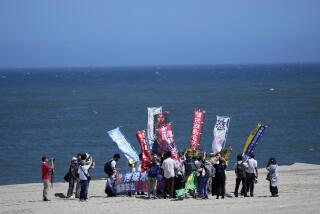Nuclear Waste Export Plan Raises Fears About Route
- Share via
WASHINGTON — The Energy Department has quietly sold West Germany $20-million worth of highly radioactive cesium and strontium and is seeking to clear the way for its shipment from Hanford, Wash., to the Pacific Coast, then through the Panama Canal and across the Atlantic.
It would be the first large-scale export of high-level nuclear waste material, and officials of the environmental activist organization Greenpeace said Thursday that they would attempt to block the shipments.
The West German government arranged in 1984 to buy the 9.5 tons of waste from nuclear weapons production for use in experiments and tests of permanent nuclear waste storage in abandoned salt domes.
Made Into Glass Logs
The Energy Department’s Hanford operation has processed the waste, which emits twice as much gamma radiation as waste from commercial power reactors, into 3-foot-long glass logs weighing 595 pounds each.
Under the arrangement between the two governments, the waste material will be loaded into 27,500-pound shipping casks and turned over to the Germans at Hanford for shipment by a private contractor.
Initial plans called for the first of three shipments to be made this fall, but officials with the Energy Department and the state governments of Oregon and Washington said that arrangements are unlikely to be completed until at least next spring.
Trucked Through Gorge
Tentatively, it is expected that the casks will be trucked from Hanford on Interstate 84 through the Columbia River gorge to the port of Portland.
But Dan Silver, special assistant to Washington Gov. Booth Gardner, said that state officials had been advised that the port of Seattle has not been ruled out as an alternative to Portland.
Officials in Oregon and Washington said that they are willing to approve shipment through their states if they are convinced that all safety precautions have been taken.
Even so, “we have a long way to go,” Silver said. “We are at the beginning of reviewing the documentation. We are very much in the preliminary stages. But there will be public hearings and people will have to be satisfied that this is safe.”
May Get Full Review
The Energy Department is expected to complete an environmental assessment report in November. And a department spokesman said that the shipment may require a full environmental impact statement, which would provide for public hearings and comment on the proposal.
Although there are obvious safety concerns, Silver said, “our position is that we must transport nuclear waste . . . to have a clean and safe environment, and, therefore, we need to establish procedures and the means to safely transport.”
Germany wanted the processed material to serve as heat sources that would simulate the waste generated by its own nuclear power reactors.
Salt Domes Considered
In looking for ways to dispose of reactor waste, the United States earlier considered salt domes in Kansas as disposal sites because the heat from the radioactive material speeded the natural closure of mined salt deposits. That phenomenon held the promise of permanently and safely sealing away the waste material.
But the salt domes fell from favor because of concerns about possible water penetration of the deposits, and the search turned elsewhere.
Although the sales agreement with Germany was concluded five years ago, the Energy Department did not contact local officials about transporting the material from Hanford to Germany until recent weeks.
Rejects Barging
Initially, officials were told, there was consideration of barging the casks down the Columbia River. But Edlow International, the firm hired by the Germans to handle the shipping, favored surface transportation.
David Stewart-Smith of the Oregon Department of Transportation said that the company is now leaning toward shipment by truck rather than rail because it believes it would retain stronger control over a trucking company than a railroad.
More to Read
Sign up for Essential California
The most important California stories and recommendations in your inbox every morning.
You may occasionally receive promotional content from the Los Angeles Times.













